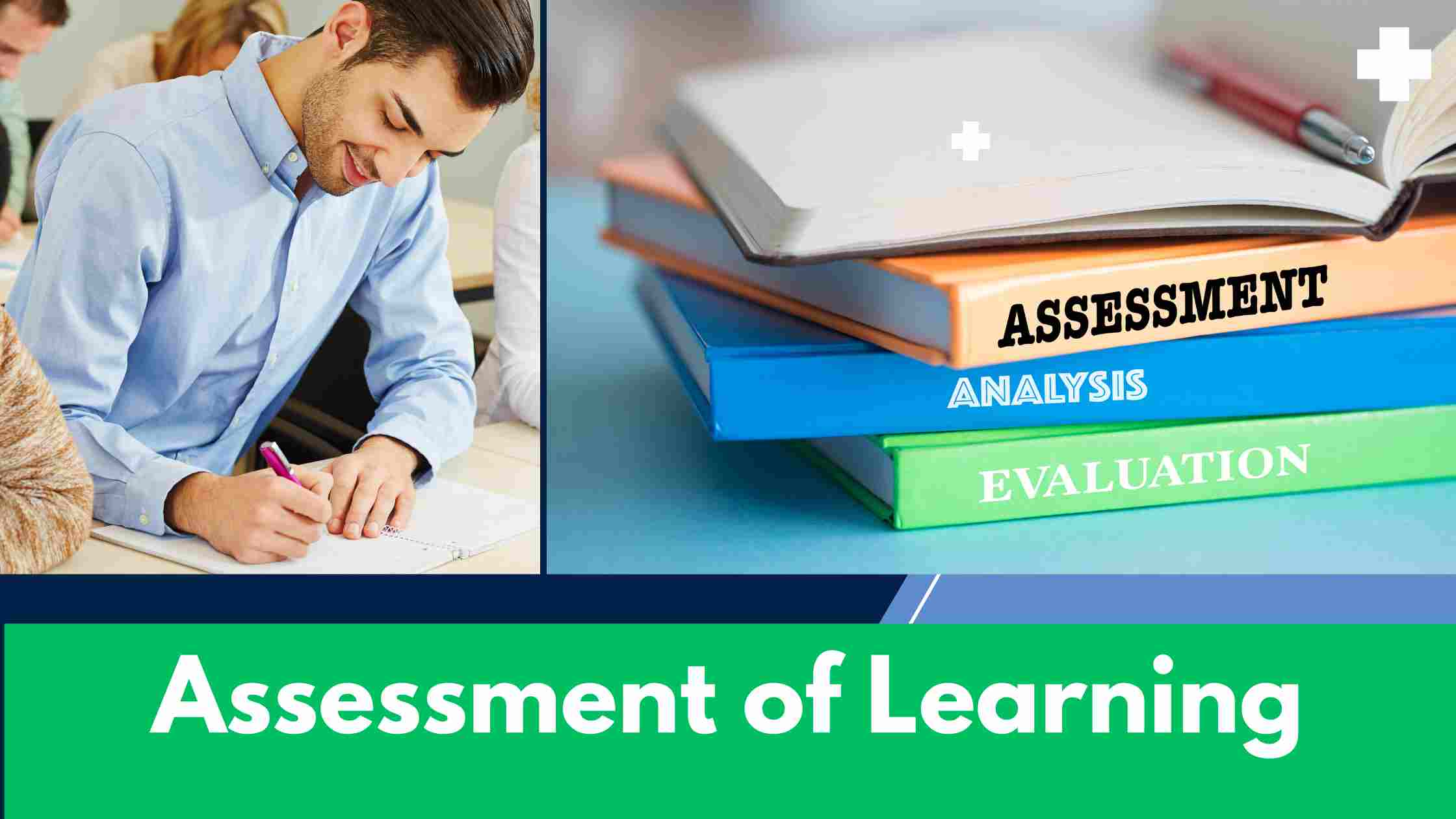Assessment of learning is the process of gathering evidence to determine what a student has learned. It is frequently used as a final exercise to assess a student’s comprehension of the subject matter. Assessment can be done in many ways, such as through tests, quizzes, essays, and assessment portfolios. It can also assess a student’s progress and identify learning trends. Individualized learning plans for students can be created using the information provided.
Assessment of learning serves as a means to evaluate the effectiveness of teaching methods and curriculum and provide feedback to students on their progress. This article will explore the various aspects of Assessment of learning, including its purpose, types, and challenges.
The purposAssessmenAssessment of learning is multifaceted. Firstly, it enables educators to determine how students have achieved the desired learning outcomes. Educators can pinpoint areas for more instruction or support by assessing students’ knowledge and skills. Moreover, learning assessment plays a crucial role in promoting accountability assessment systems, as it provides evidence of students’ achievement and helps monitor the quality of education.
There are several types of assessment methods for learning. Traditional methods include written examinations, quizzes, and essays, which assess students’ understanding of the subject matter. On the other hand, performance assessments involve practical tasks or projects that require students to apply their knowledge in real-world scenarios. Another approach is formative Assessment, conducted throughout the learning process to provide immediate feedback to students and guide instructional decisions. Despite the importance of Assessment in learning, it is not without challenges. One of the major challenges is the risk of bias, as different factors such as cultural backgrounds or socioeconomic status may influence the results.

Assessment of Learning as a Summative Assessment
Grades, Exams, and Rubrics are commonly used as summative assessments in education to determine a student’s understanding and mastery of a subject. Grades are a quantitative performance measure based on exams, assignments, and other assessments. Exams are formal assessments that test students’ knowledge and skills within a specific time frame. Rubrics provide a structured framework for evaluating student work, providing clear criteria for grading. These subtopics are crucial in learning assessment, providing educators with objective measures to gauge student progress and inform instructional decisions.
Grades
Educators often rely on summative assessments to evaluate students’ performance and achievement. These assessments are typically administered after a period of instruction and are designed to measure the extent to which students have mastered the intended learning outcomes. One common form of summative Assessment is the assignment of grades.
Grading systems vary across educational institutions but generally involve assigning numerical or letter values to represent a student’s achievement level. Grades serve as a quantitative measure of a student’s performance. The assessment provides a basis for comparison among their peers. They also serve as a feedback mechanism, helping students understand their strengths and areas for improvement.
To better understand the grading system, consider the following example:
| Grades | Percentage Range |
|---|---|
| A | 90-100% |
| B | 80-89% |
| C | 70-79% |
| D | 60-69% |
| F | Below 60% |
A combination of factors, such as exams, assignments, and class participation, typically determines grades. However, exams play a crucial role in the grading process.
Exams
Exams are a common form of Assessment used in education to evaluate students’ knowledge and understanding of a subject. They provide a structured and standardized way to measure learning outcomes. They are often used as a summative assessment, assessing students’ performance at the end of a course or unit of study.
Grades are typically assigned to exams to reflect students’ levels of achievement. These grades are often based on a predetermined grading scale, including letter grades (A, B, C, etc.) or numerical scores (out of 100 or a specific range). Grades provide a clear and concise way to communicate students’ performance to the students and other stakeholders, such as parents or employers.
To ensure fairness and consistency in grading, rubrics are often used. A rubric is a set of criteria that outline the expectations for different performance levels. It provides a clear framework for assessing students’ work and helps ensure that grading is objective and consistent across different examiners. Rubrics can be especially useful for subjective assessments, such as essay questions, where multiple aspects of the response must be evaluated.
To further illustrate the importance of exams as a summative assessment, consider the following table:
Rubrics
Transitioning from the discussion of exams, learning assessment can also be done through rubrics. Rubrics provide a structured and objective way to evaluate student performance based on specific criteria. They offer a clear set of expectations, allowing both students and educators to have a shared assessment of what is required for each level of achievement.
Rubrics can be a powerful tool in the summative assessment process, as they provide a detailed breakdown of the assessment and the corresponding proficiency levels. This allows for a more accurate assessment and evaluation of student work. Using rubAssessmentators can ensure that their grading is fair and objective, based on predetermined standards rather than personal bias.
What Is Summative Assessment in Education?
Now that we have discussed the Assessment of Learning As a summative Assessment, let us delve deeper into what summative Assessment means in education.
Summative Assessment is an evaluation method used to measure students’ learning outcomes and achievements at the end of a particular course, unit, or instructional period. It is typically administered after significant instruction and is designed as a comprehensive overview of a student’s understanding and knowledge of the subject matter.
The primary purpose of Assessment is to judge students’ overall performance and determine whether they have achieved the desired learning outcomes. It often involves formal exams, standardized tests, final projects, or essays. These assessments are usually scored based on predetermined criteria and are used to assign final grades or determine the level of achievement.
Unlike formative Assessment, which focuses on providing feedback and guiding student learning during the instructional process, summative Assessment is used to evaluate the effectiveness of the teaching and learning that have taken place. It helps assess how much students have mastered the content and skills taught throughout the course.
One of the key benefits of summative assessment is its ability to provide a snapshot of a student’s performance at a specific time. This information can inform instructional decisions, identify areas for assessment, and make important educational decisions such as promotion, graduation, or entrance into higher education programs.
Importance of Summative Assessment
In addition to understanding what summative Assessment in education is, it is important to recognize the significance of this assessment method in the learning process. Summative Assessment is crucial in evaluating students’ knowledge and skills, providing valuable feedback, and guiding future instruction.
One of the primary purposes of summative Assessment is to measure student achievement at the end of a learning period or course. By assessing students’ understanding of the entire curriculum, summative assessments enable educators to determine whether learning goals have been met. This information is essential for tracking individual and group progress, identifying assessment strengths and weaknesses, and making informed decisions about instructional strategies.
Moreover, summative assessments provide students with a sense of accomplishment and closure. After investing time and effort into their learning, students can view summative assessments as an opportunity to showcase their knowledge and skills. This can foster a sense of pride, motivation, and self-confidence, which are important factors in promoting continued learning and engagement.
Another key benefit of summative Assessment is its ability to provide valuable feedback to students and educators; summative assessments highlight improvement and further development by comprehensively evaluating students’ performance. This feedback can guide students in their future assessment endeavors, helping them identify specific areas to focus on and strategies to enhance their understanding. For educators, summative assessments provide insights into the effectiveness of their instructional assessment to make adjustments and improvements for future teaching.
In addition, summative assessments contribute to the accountability and transparency of educational learning.
Summative Assessment Examples
The importance of summative Assessment has been established in the previous section’s assessment of its role in providing a comprehensive evaluation of students’ assessments. In this section, we will delve into a specific aspect of summative Assessment, namely its use as an assessment. Additionally, we will explore examples of summative assessment methods commonly employed in educational settings.
Summative Assessment, as an assessment of learning, aims to measure students’ achievement and mastery of the content and skills taught throughout a specific period. Unlike formative Assessment, which focuses on providing feedback to improve learning, summative Assessment is Assessment making judgments about students’ level of understanding and performance.
One example of summative Assessment is the standardized test. These tests are designed to assess students’ knowledge and skills in a standardized manner, enabling comparisons across different schools, districts, or even countries. The results of these tests are often used for accountability purposes, such as evaluating schools’ effectiveness or determining students’ eligibility for certain programs.
Another example of summative Assessment is the final examination. Typically administered at the end of the assessment or academic year, these exams assess students’ overall understanding of the material. They often cover a wide range of topics and require students to demonstrate their knowledge through various question formats, such as multiple-choice, short-answer, and essay questions.
Portfolios can also serve as a summative assessment tool. In this approach, students compile a collection of their work over time, showcasing their progress and achievements.
Summative Assessment Tools
Summative Assessment is essential to the educational process as it comprehensively evaluates students’ learning at the end of a unit, course, or academic year. Educators utilize various summative assessment tools to measure students’ understanding and mastery of the material effectively. These tools objectively measure student achievement and offer valuable insights into the effectiveness of instructional strategies and curriculum design.
One commonly used summative assessment tool is the standardized test. These tests are administered to students across a wide population and are designed to assess their knowledge and skills in specific subject areas. Standardized tests provide a standardized measure of achievement that can be used to compare students’ performance against national or international benchmarks. Examples of standardized tests include the SAT, ACT, and state-mandated assessments.
Another effective summative assessment tool is the project or portfolio. These assessments allow students to demonstrate their understanding and application of knowledge by creating a product or collection of work. Projects and portfolios can be tailored to individual student interests and learning styles, providing a more authentic and meaningful assessment experience. For example, a science project may require students to design and conduct an experiment, analyze the data, and present their findings.
Performance-based assessment is widely used as a summative assessment tool. These assessments evaluate students’ ability to apply their knowledge and skills in real-world scenarios. Performance-based assessments can take many forms, such as oral presentations, debates, simulations, or demonstrations.
Summative Assessment Sample
Now that we have discussed the various tools used for summative assessments, it is important to understand what a summative assessment sample entails. A summative assessment sample represents the type of Assessment given to students at the end of a learning period to evaluate their understanding and knowledge of the material covered. These samples are designed to be comprehensive and cover a wide range of topics to assess a student’s overall performance accurately.
One example of a summative assessment sample is a standardized test. These tests are administered to students on a large scale and are often used to measure a student’s proficiency in subjects such as math, science, or English. Standardized tests typically include multiple-choice, short-answer, and sometimes even essay questions. The results of these tests are used to compare students’ performance to a predetermined standard or benchmark.
Another example of a summative assessment sample is a final project or presentation. In many courses, students must complete a final project or presentation demonstrating their understanding of the material covered throughout the course. These projects often require students to apply their knowledge creatively and practically. For example, a science class may require students to design and conduct a scientific experiment. On the other hand, students in an English assessment must analyze a piece of assessment and present their findings to the class.
Summative assessment samples are valuable tools for educators to evaluate students’ learning and understanding comprehensively. These samples help educators identify areas of strength and assessment, allowing them to tailor their instruction to meet the needs of their students better.
Summary
In conclusion, the assessment of learning plays a crucial role in the educational system Assessment of summative Assessment. As discussed earlier, summative Assessment is a method used to evaluate assessment knowledge and skills at the end of a learning period. It provides a comprehensive overview of the student’s overall performance and understanding of the subject matter.
The importance of sumAssessmAssessment cannot be ignored. It allows educators to gauge the effectiveness of their teaching methods and curriculum, ensuring students meet the desired learning outcomes. Educators can use summative Assessment to identify areas of weakness and tailor their instruction accordingly. Additionally, summative Assessment provides students with a clear understanding of their strengths and weaknesses, allowing them to focus on areas that require improvement.
Various tools and methods can be used for summative Assessment, depending on the subject and grade level. These tools can range from traditional exams and quizzes to performance-based assessments, projects, and portfolios. The choice of assessment tool should align with the learning objectives and accurately represent the students’ knowledge and skills.
In conclusion, summative Assessment serves as an essential evaluation tool in education. It allows educators to measure students’ learning outcomes, identify areas for improvement, and ensure that educational objectives are being met. By utilizing appropriate summative assessment tools, educators can provide meaningful feedback to students, promote growth, and enhance the overall learning experience.







[…] Assessment of Learning refers to evaluating students’ knowledge and skills at the end of a specific period or course. It is often used to measure students’ achievement and summarize their learning outcomes. This type of assessment is typically conducted through tests, exams, and standardized assessments. Its main purpose is to determine the extent to which students have mastered the content and skills outlined in the curriculum. […]
[…] developing personalized learning goals and action plans for improvement. This approach differs from assessment for learning, which focuses on using assessment to inform instruction, and assessment of learning, which is used […]
[…] achievement. In differentiated instruction, teachers adapt instructional methods, materials, and assessments to meet the diverse learning profiles of students. This facilitates a student-centered environment, which promotes meaningful […]
[…] Assess Learning Outcomes: Develop assessment strategies that measure students’ understanding, application of knowledge, and critical thinking skills demonstrated through experiential learning. […]
[…] addition to engagement, observing student behaviors also allows educators to assess students’ understanding of the material being taught. Teachers can identify confusion or […]
[…] assessment plays a crucial role in enhancing student learning. Assessing allows educators to gain insights into students’ understanding, identify areas of […]
[…] learning, assessing students’ progress may sometimes be difficult. Unlike standard assessment forms, project-based learning necessitates a complete evaluation strategy. Teachers may address […]
[…] in education is a way of teaching and learning that focuses on the ideas and values that have existed for a long time in Western culture. It talks […]
[…] assessment, also referred to as assessment of learning, is typically used to evaluate students’ mastery of specific skills or knowledge after a […]
[…] Interactive Technology: Leverage interactive technology to engage students, foster collaboration, and assess learning. […]
[…] needs is recognizing students’ varying academic strengths and weaknesses. This involves assessing their prior knowledge, identifying gaps, and adapting teaching methods accordingly. For example, if […]
[…] may assess student learning using several assessment techniques in the Discovery Learning Method, such as formative assessments, self-assessments, and peer assessments. Teachers may also […]
[…] Assessment involves systematically gathering information and data about student learning and performance. It is broader than testing and includes teachers’ methods to observe, measure, and evaluate student learning progress and outcomes. For instance, assessments can include formal tests, quizzes, projects, lab reports, presentations, homework assignments, class participation, and more. They provide ongoing checks for understanding throughout instruction. […]
[…] about how you will test what students have learned and give them feedback. Will there be a formal assessment, such as a quiz or test? Or will you provide feedback informally through observation and […]
[…] Different strategies are examined, including proactive, reactive, relationship-building, instructional, and assessment. […]
[…] Monitoring: Regular assessment of the program’s effectiveness and adjustments based on […]
[…] third concept of education focusing on the child is that learning should be inclusive and sensitive to cultural differences. Teachers must develop inclusive learning […]
[…] the success or failure of the educational system. By having well-defined aims, educators can assess whether they have achieved their goals and make necessary adjustments to improve educational […]
[…] Learning Goals: Communicating and explaining learning goals to students and providing regular feedba… their progress. […]
[…] may not be easy to assess and evaluate student […]
[…] perspective can also be applied to education, where it emphasizes the importance of experiential learning and encourages a positive approach to education. In this article, we will explore the concept of positive method or positive learning in […]
[…] Assessment and Evaluation: Developing fair and consistent assessment methods can be complex when multiple teachers are involved. It requires alignment of grading criteria, ensuring consistency in feedback, and maintaining accurate records of student progress. […]
[…] to assess social and emotional learning in schools are crucial to ensuring the effectiveness of SEL implementation. Assessment methods […]
[…] Assessment and Feedback: Assessment plays a crucial role in identifying the best teaching method for optimal learning. Continuous assessment provides valuable insights into student progress, […]
[…] is a critical aspect of the educational process, allowing educators to gauge student learning and make informed decisions about instruction. Within the broad category of assessment, various […]
[…] among your students. Empower them to develop metacognitive skills by reflecting on their language learning journey and setting personal goals for improvement. This process cultivates a sense of ownership, […]
[…] a relativistic view of morality and neglect the value of aesthetic experiences in education. When assessing the benefits and drawbacks of Pragmatism as an educational philosophy, it is crucial to consider these […]
[…] come across. This could include presenting students with opposing viewpoints or encouraging them to assess the strengths and weaknesses of various […]
[…] evaluation involves continuous inspection and forming valid judgments about students’ learning or the effectiveness of an education […]
[…] revolt against the traditional belief that the learner should sit at the educator’s feet and learn anything that is thrown at him by the education. […]
[…] or a molder of character. These the child will forge for himself, he knows better than any educator what he should learn, when, and how he should learn it. His education is the free development of his interests and […]
[…] learning styles. Additionally, Pear Deck provides valuable analytics and data insights, enabling educators to assess student understanding and make informed instructional […]
[…] Many factors influence a child’s success in school. Some of these factors include family income, education, home environment, and the quality of the teacher. If you want to be successful in your child’s education, you must be prepared for the challenges they will face. Getting your child into the best schools is difficult, but it is possible. You need to know the right thing to do. Read this article to learn how to be successful in your child’s education. […]
[…] Assessment: Assessment methods in a naturalistic classroom might include lab reports, research projects, and experiments. Students are evaluated based on their ability to apply scientific concepts, gather data, and draw conclusions from observations. […]
[…] Assessment-Driven: Traditional approaches typically rely on standardized assessments to measure student learning. […]
[…] the success or failure of the educational system. By having well-defined aims, educators can assess whether they have achieved their goals and make necessary adjustments to improve educational […]
[…] abilities in the classroom. Teachers should employ various instructional approaches, materials, and assessments to address individual learning styles and levels. By adapting instruction to meet student’s unique requirements, teachers foster […]
[…] Formative assessment for assessment learning […]
[…] the experimental treatment. This group provides a baseline for comparison, helping researchers assess the true effect of the independent […]
[…] expectations, fostering positive relationships, and creating opportunities for student agency, educators can cultivate a thriving learning environment where all students can reach their full […]
[…] model represents a paradigm shift in traditional teaching methods, revolutionizing the way educators deliver instruction and engage students in learning. In this innovative approach, instructional content is flipped, with students accessing materials […]
[…] is an important area of study for educators because it informs our understanding of how students learn and how knowledge is […]
[…] in Mental Health Care: Psychology has practical applications in mental health care, offering assessment, diagnosis, and treatment services for individuals experiencing psychological distress or […]
[…] resilience, and well-being among students. It investigates factors that contribute to positive educational experiences and seeks to optimize conditions that facilitate learning, growth, and […]
[…] and findings from educational psychology, teachers can effectively design educational experiences, assess learning outcomes, and foster student engagement and […]
[…] assessments directly to learning objectives and standards. Be clear on what knowledge and skills are being […]
[…] of the pandemic, schools in Pakistan have had to switch to online learning so that students can still get an education during the lockdown. Online learning has become a meaningful way to deal with the problems caused […]